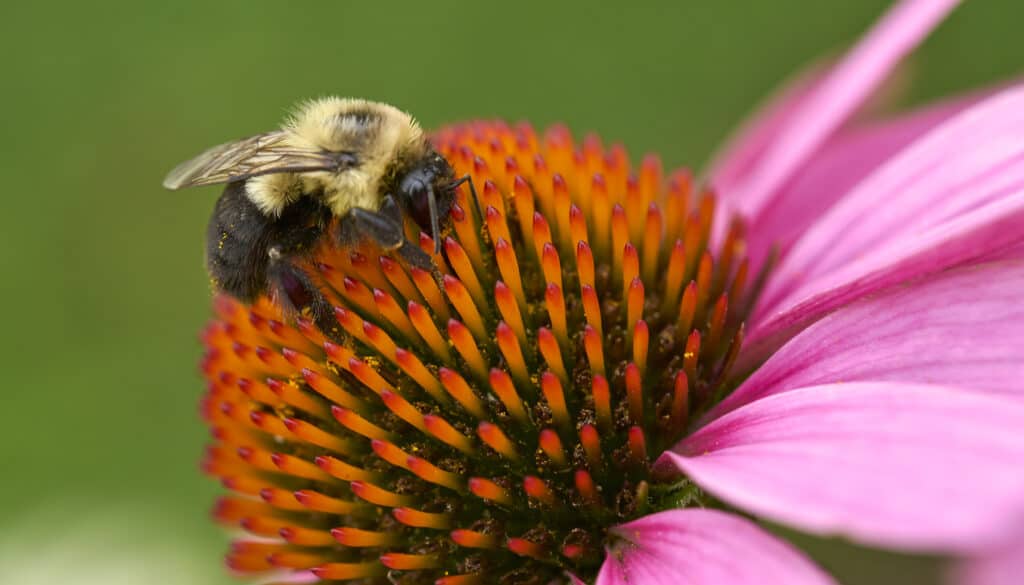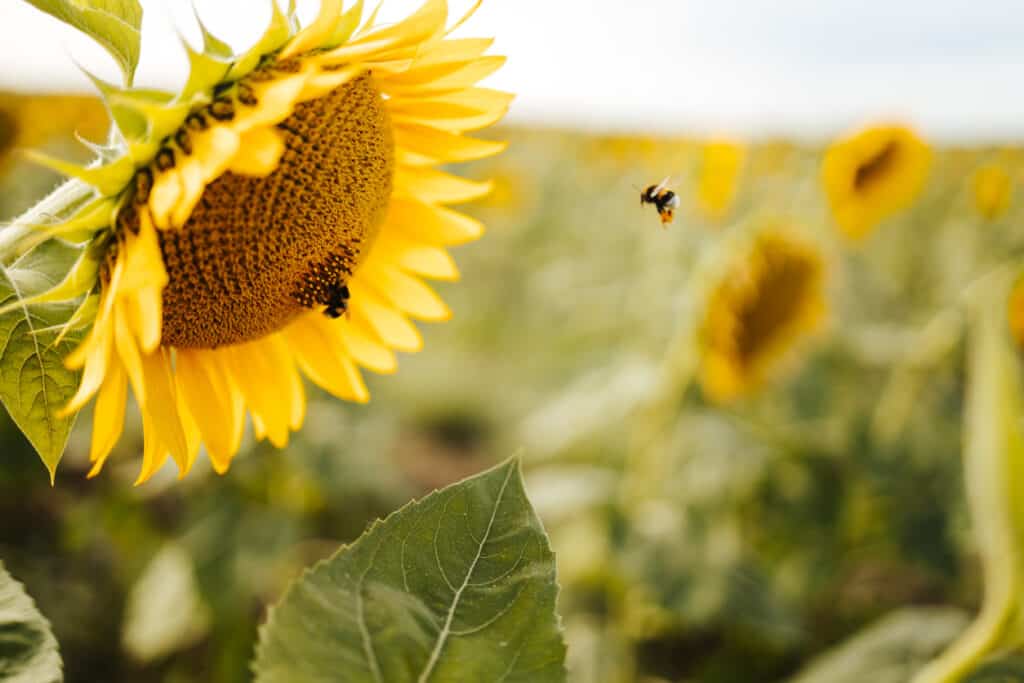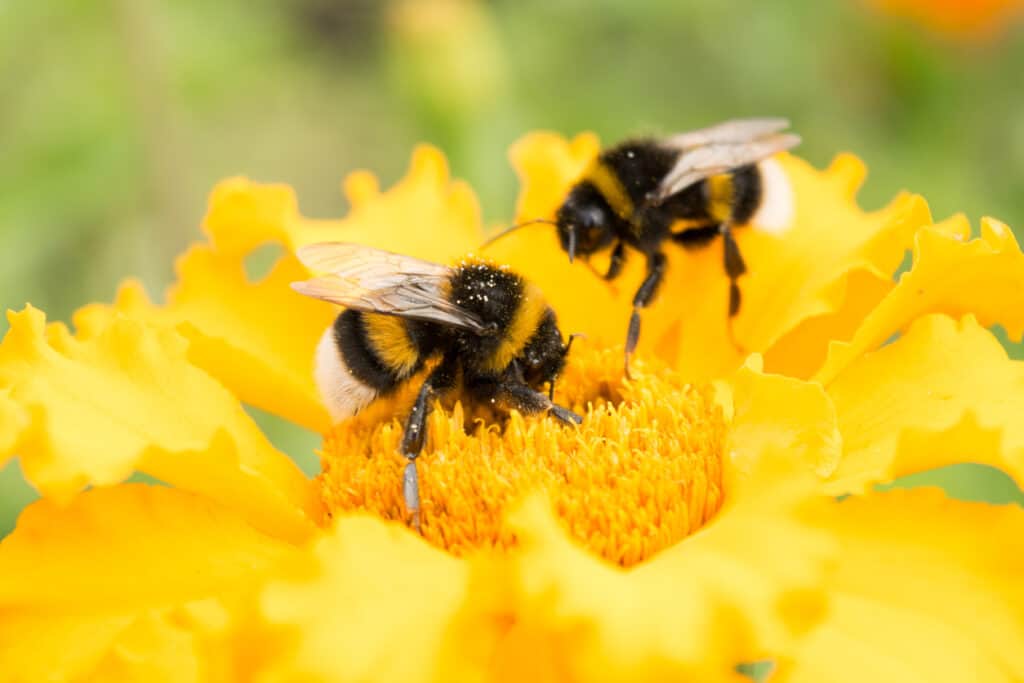Since bumblebees are usually bigger and broader than honeybees, it can be a bit intimidating to have them buzzing about when you’re gardening. Because of their larger size compared to a honeybee, it is natural to wonder if they deliver an amplified level of pain if you get on the wrong side of one and if they can bite.
Bumblebees have mandibles, but they would be ineffective on human skin. Bumblebees bite into leaves to induce plants to flower earlier. They also bite flowers to create tiny holes to reach nectar stores. Female bumblebees can sting. Bumblebees are docile and only sting if they feel threatened.

Anyone who has spent time in a colorful summer garden will know the familiar, lazy-sounding buzz of bumblebees as they dawdle from flower to flower, relishing every moment of the warm sunshine. Let’s learn more about bumblebee bites, stings, and the difference between the two!
Do Bumblebees Bite?

Surprisingly, bumblebees do bite, but in the way you expect! A bumblebee can’t bite human skin the same way as a tick or a crocodile since the structure of their mouths is modified to effectively harvest nectar from flowers. But they can make tiny bites on plant leaves, and they do this for a very particular reason.
Scientists doing research at the Swiss Federal Institute of Technology in Zurich were astonished to discover that the bumblebees being studied made tiny nicks in the leaves of plants that weren’t flowering. They weren’t eating anything or taking any material away with them; they just made a series of tiny bites.
This bumblebee behavior seemed a little odd until the team realized that the small punctures on the plants induced them to flower earlier. Bumblebees were planning ahead and effectively encouraging their food supply to produce ahead of schedule.
According to the theory, flowers and pollinators need each other and have a mutually beneficial relationship. To survive, bumblebees need food, and flowers need to be fertilized. Over millions of years, they have found ways to communicate so that they stay in sync with each other – it’s no good if a flower blooms when the bumblebees have all died of starvation a few weeks too soon.
Humans are only now cracking this intricate code. Early findings suggest that when bumblebees are short on food, they will actively seek out plants that have yet to flower and purposely bite the leaves. In a study published in Science, the bites from pollen-deprived bumblebee colonies caused black mustard seed plants to flower two weeks sooner than usual, and tomatoes flowered a month earlier than expected.
So, in short, bumblebees can and do bite, but only as a method to communicate to their plant allies that they need to hurry things along and get blooming. Although the tiny bites damage the leaves, they do not destroy the plant or affect its ability to produce flowers. Bumblebee bites would be utterly ineffective against a human or another animal.
What Do Bumblebees Use Their Mandibles For?

We know that bumblebee mandibles aren’t effective on human skin, and new research has indicated that these fascinating insects stimulate plants to flower by biting the leaves. However, their jaws also have a few other important functions.
Their tiny mandibles may be ineffective as a defense mechanism, but they are pretty handy tools for these insects. It turns out that bumblebee jaws have several uses.
- Creating shortcuts to nectar – Bumblebee mandibles may not be particularly powerful, but they are effective on soft plant material. They can bite their way through the sides of flowers to make a shortcut to the nectar stores if their long sticky tongue is too short.
Trumpet-shaped flowers like Trumpet Vine are a favorite among bees or all species. The challenge for large bumblebees is that the sweet nectar is deep inside the tube. A few quick bites on the base of the flower, and voila, the bumblebee can dip its tongue into the nectar-like a straw. This is a really handy feature for bumblebee species that have shorter tongues.
- Buzz Pollination Aka Sonication – Some flowers like to make certain that pollination is going to happen, so they make it a little more challenging for visiting insects to loosen pollen. The little bumblebee grasps the flowers’ antlers with its mandibles and then moves its flight muscles to cause a vibration that signals the plant to release pollen.
Bumblebees play a vital role in pollinating plants like eggplants, tomatoes, potatoes, cranberries, and blueberries which rely on this method of pollination. Interestingly, honeybees cannot perform this type of pollination, so the preservation of bumblebees and other solitary bees is essential for pollinating these crops.
- Biting Out of their Cocoons – This is a once-off, but new bumblebees make their way into the world by biting their way out of their cocoons using their mandibles. Like all bees, bumblebees go through the life cycle of egg, larva, and pupa before chewing a hole out of their comfy little pod and joining the rest of the colony.
Bumblebee Vs. Carpenter Bee Mandibles
Bumblebees are often the victims of mistaken identity. If you have a wooden deck and notice a bee-like insect boring a hole into the wood, it is undoubtedly a carpenter bee, not a docile little bumblebee. However, it is safe to say that neither a bumblebee nor a carpenter bee would succeed in biting you.
Although the mandibles or carpenter bees are significantly harder than a bumblebee, they use their mouthparts to rasp away at wood to make nest holes. They do not eat the wood in the same way as termites, and they are only boring away at the wood to make safe tunnels to lay their eggs.
That is not to say that bumblebees wouldn’t make use of a preexisting hole drilled in a piece of wood to make a nest. However, their mandibles are too soft and not adapted to effectively bore away at solid items and be destructive.
Do Bumblebees Have Teeth?
No bee of any variety can take large bites of anything in the same way as a human may take a bite from an apple. Bumblebees only have teeth in cartoon drawings, so you don’t have to worry about having a tetanus shot handy when you are out and about in nature with these fuzzy insects.
Bumblebees live off soft food like honey, nectar, and pollen. They have long sticky tongues to lap up the nutrients they need, and the inside of their tiny mouths only consists of some tiny hair-covered pores and receptor cells that enable the insect to taste its food.
The outside mandibles, which are common to all species of bees, do not resemble teeth. They are more like tiny cutters and can also be used to grasp or move tiny objects, for example, when cleaning the nest. Bumblebees don’t have incisors or teeth to sink into you, and since they are extremely docile insects, so even if they did, they probably wouldn’t want to.
Are Bumblebees Aggressive?
Bumblebees appear almost comical in their lumbering slowness compared to their ultra-organized, social honeybee cousins. They are the larger, chilled, fuzzy versions of cute bees and look almost huggable.
Although you definitely don’t want to push your luck and actually try to hug a bumblebee, these gentle giants try to avoid trouble and usually just buzz off to a safer spot if they feel like you are too close. If they feel threatened, the females can sting, but this is pretty rare and usually only happens if they feel cornered or if you are disturbing their nest.
Do Bumblebee Stings Hurt More Than Honeybee Stings?
According to the Schmidt sting pain index, the sting from a honeybee and a bumblebee are both set on pain level 2. However, there are some significant differences between encounters with these two insects if you are on the receiving side of their stinging end.
- A female bumblebee can sting multiple times, whereas each honeybee can only sting once. So it would definitely be preferable to get a honeybee stuck between your shirt and your skin than a bumblebee!
- A honeybee has a barbed stinger, while a bumblebee stinger is smooth.
- A bumblebee is less likely to sting and usually only does so if they are threatened, or the nest is under attack
- Honeybees are more likely to swarm, and if you disturb a group, there is a much higher danger factor as they may collectively try to ward off danger. Bumblebees are less inclined to swarm.
For most people, getting stung by a bumblebee is painful for a short period, but it does not create any lasting problems. However, the severity and reaction to the sting can be affected by the number of times the person was stung or if the victim has an allergic reaction to the venom.
Local discomfort, swelling, and itchiness are to be expected immediately after a bumblebee sting. It wouldn’t be called a sting if it didn’t hurt! Anyone allergic to bee stings must take a bumblebee sting very seriously and immediately seek medical treatment as they will experience the same life-threatening allergic response to bumblebee stings.
Do Bumblebees Sting Pets?
Bumblebees are unlikely to attack any animals for the purpose of stinging. They are more docile than honeybees or wasps and will usually buzz off away from any threats.
Although this is a reassuring trait, and we all must encourage bumblebees to visit our gardens, our inquisitive pets may sometimes bite off a little more than they can chew. Dogs, and even cats, have been known to swallow insects while playing. Bumblebees that become trapped inside houses against windows are a particular magnet for curious cats.
Swallowing a bumblebee will be a painful accident that your pet will undoubtedly regret. Unlike honeybees, these cute fuzzy pollinators can sting multiple times, so if your dog somehow manages to swallow a live bumblebee, it could get stung all the way down and into its insides. However, unless the pet has an allergic reaction, which would include symptoms like drooling, pale gums, or difficulty breathing, ingesting a bumblebee will probably just lead to gagging and coughing.
More than likely, if your pet does swallow a bumblebee, the insect will die on the way down and quickly start getting digested. Owners should remain calm, and if their pet only has a bit of local swelling and a mild reaction, no action may be required. Contact a veterinarian immediately if the animal is in severe pain, vomiting, or having trouble breathing.
Can You Pet A Bumblebee?
Bumblebees are super cute and fuzzy, and if you are out and about in the garden, you may be tempted to try to stroke one if it lands near you. Although these little insects will tolerate more interaction with humans than wasps or honeybees, it is better not to try to touch them.
As tempting as their soft fluff may be, touching a bumblebee may make it feel threatened, and you could get stung – multiple times. You could also injure the bumblebee, so if you do see one of these valuable garden pollinators, watch it, enjoy being in its presence, but don’t get too close to it.
Don’t use your hands if you need to move a bumblebee that is trapped inside your house. Gently cover the insect with a glass and slide a piece of cardboard under to hold it inside. Then immediately release it outside. Bumblebees live in small colonies of their own kind and may be frightened and act defensively if they are picked up or touched.
Conclusion
Bumblebees do not bite humans, only plants. The mandibles of these valuable insects are adapted to make incisions in soft plant material to create shortcuts to nectar stores or signal plants to speed up the flowering process. They also bite their way out of their cocoons when hatching.
Female bumblebees can sting multiple times with their stinger, but bumblebee bites are ineffective as a defense method.
References:
https://www.nationalgeographic.com/animals/article/bumblebees-bite-plants-flower-early#
https://www.buzzaboutbees.net/do-bumble-bees-bite.html
https://www.earthrangers.com/top-10/top-ten-things-you-didnt-know-about-bumble-bees/#
https://www.nature.com/articles/d41586-020-01561-9#
https://www.almanac.com/10-things-you-didnt-know-about-bumblebees-friendly-fuzzy-bee https://www.orkin.com/pests/stinging-pests/bees/bumblebees/bumblebee-sting-facts

